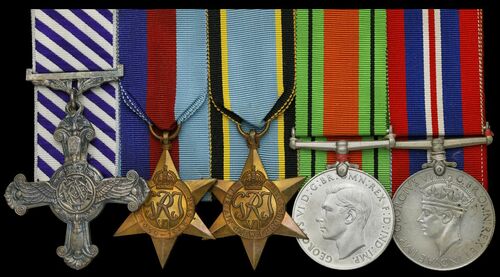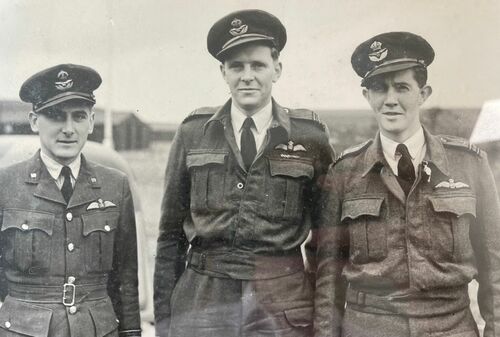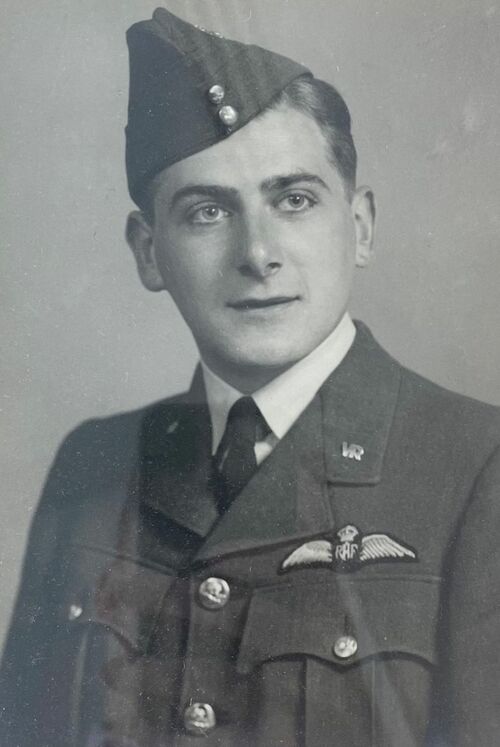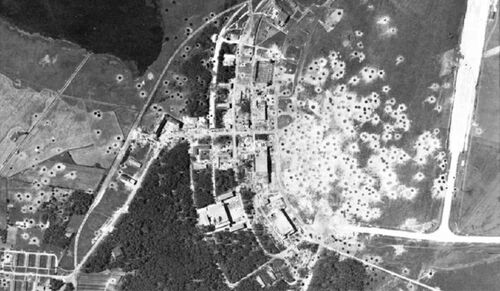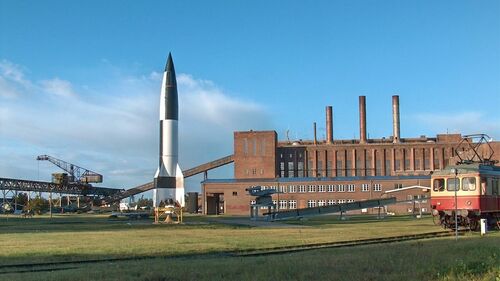Auction: 23002 - Orders, Decorations and Medals
Lot: 126
A very fine 1943 D.F.C. group of five awarded to Squadron Leader A. S. Raphael, No. 467 Squadron, Royal Australian Air Force, a gallant Jewish airman who led his Squadron in the famous Peenemünde raid in August 1943, being killed in action on that costly occasion
Distinguished Flying Cross, G.VI.R., the reverse officially dated '1943' and additionally inscribed 'Sqd. Ldr. A. S. Raphael 467 Sqd.', with its Royal Mint case of issue; 1939-45 Star; Air Crew Europe Star, these last two privately impressed 'Sqd Ldr A S Raphael 467 Sqd'; Defence and War Medals 1939-45, good very fine (5)
Ex-Gaston-Grubb Collection.
D.F.C. London Gazette 13 August 1943:
'Squadron Leader Raphael has completed many successful operational sorties. In September 1941, he was detailed to attack Berlin and despite adverse weather, pressed home his attack in the face of intense opposition. Over the target area his aircraft was hit and badly damaged, nevertheless this officer completed the mission.
As Captain of an aircraft, he took part in the successful raid on the radio-location factory at Friedrichshaven and on the Italian naval base at Spezia, made during the return flight from North Africa.
For some time Squadron Leader Raphael has been acting as Deputy Flight Commander, a post he has filled most efficiently, setting a very high standard to all personnel under his command.'
Alfred Sydney Raphael - or Ray to his friends and comrades - was born in Maida Vale, London in November 1916 and was one of a handful of Jewish Pilots who flew in Bomber Command during the Second World War. Raphael was commissioned Pilot Officer on 16 March 1941 and flew with No. 467 (Australian) Squadron. The Royal Australian Air Force unit was formed at Scampton in November 1942 and first operated with Lancasters in January 1943. They began under the command of Wing Commander C. L. Gomm, D.S.O., D.F.C., with whom Raphael and Flight Lieutenant J. M. Desmond were photographed after their Raid on Dortmund, at that time the largest of the Second World War. Gomm would be killed in action on 15 August, thus it was Raphael - who was at that time in command of 'A' Flight - who was to assume command of the Squadron.
Peenemünde
Raphael's had notched up some 18 sorties before his final - fateful - operation would see him share in the famous attack on the enemy’s top secret rocket experimental station at Peenemünde, 17-18 August. For some weeks now the Squadrons of No. 5 Group had been practising ‘indirect bombing’ techniques at Wainfleet range, carrying out runs at fixed speeds and heights from identifiable landmarks, and dropping bombs on the stopwatch rather than using a bomb sight. Crews guessed that an attack on a precision target was in the offing. Pilot Officer Bill Close, Navigator on Flying Officer ‘Fish’ Whiting’s crew wrote:
'On the afternoon of 17th August the whole squadron was briefed for a night attack on a place we had never heard of before – Peenemünde – described by the intelligence officer as German Radio Direction Finding Station. We were surprised at this as we knew that all available aircraft of Bomber Command were going to be operating either on this target or on a few others (to create a diversion ill the hopes of concealing our main target). The importance of the raid become obvious when the Group Commander himself (Air Vice Marshal Cochrane) paid a lightning visit to the briefing room to give us a pep talk. The main theme of this was that Peenemünde had to be destroyed that night, otherwise we should have to go out nightly until the job was completed. This news did not cheer us at all. Visions of the pitcher and well come before us.'
Marie Cooper recalled:
'I had a premonition that Raphael would not return as he emerged from the briefing with his usual calm gone, muttering, ‘...Too many fighters on that route!’. When the rest came out they all looked a bit ruffled and one chap said ‘...He got more than a bit worked up about the fighters,’ and then, shaking his head in an aside ‘...almost hysterical he was’.'
So it was that the Squadron supplied 10 Lancasters to the force, with Raphael at the head of his men. The bombers were being sent out despite the fact that it was a moon period, and whilst the moonlight would increase their chances of bombing accurately, it would also make them vulnerable to fighter attack.
Peenemünde was being used for the production and testing of V-2 rockets, seen as a serious threat to the progress of any invasion, which therefore had to be eliminated at all costs. No. 5 Group’s crews were told to bomb on the markers if visibility allowed, or if not, to follow their ‘indirect’ method. Either way, they were to bomb the target. Close recalled what followed:
'We left base just before nine that evening and flew eastwards. The night was clear and at our flying height of 20,000 feet the sky was alarmingly light. Behind, in front, and on each side we could see other bombers, black outlines against the light grey of the sky. It was really no night for night bombers, who rely so much for safety on the cover of darkness. Running over the western end of the Baltic, our bomb aimer, lying in the nose of the aircraft was able to call out accurate ground positions from the map, so clear was the view below. Our turning point, the little island of Bornholm came into view. By now there was a little cloud with more building up to the south. Probably, after all, we should have to bomb blind. Thirty seconds before our time to bomb, however, there was a break in the clouds and the red target indicators were there amongst much smoke and a few fires. So far we were satisfied and relieved, but we were taking no chances. Immediately after the bombs were released the pilot turned sharply to starboard on a north-westerly course and issued a reminder to the gunners to keep their eyes skinned for enemy fighters. Our own return flight was uneventful, but we had the unpleasant sight of seeing many of our bombers being attacked by fighters. Dawn was breaking as we landed after a flight totalling seven hours. All the post-raid reports confirmed the success of the attack, and the heavy price we had to pay for that success.'
Raphael was sadly on the butcher's bill, for his aircraft, LM342, crashed into a lake next to the Peenemunde research station, the only survivor being Sergeant (Rear Gunner) Adam Brand, who was thrown clear to swim ashore. Raphael's body was recovered and buried locally, likely then re-buried in an unmarked grave in the Berlin Cemetery, besides being commemorated upon the Runnymede Memorial.
Sold together with the following archive of original material:
(i)
Buckingham Palace Scroll in the name of 'P. Raphael, Esq.', glazed and framed.
(ii)
Illuminated velum memorial scroll, with his D.F.C. citation, glazed and framed.
(iii)
Two glazed and framed portraits in which he features.
(iv)
Bomber Command Medal, in its box of issue with slip in the name of 'Sqn Ldr A. S. Raphael No. 467 Squadron, KIA 17.8.1943'.
(v)
Research from Gaston-Grubb, completed in the 1970s.
Subject to 20% VAT on Buyer’s Premium. For more information please view Terms and Conditions for Buyers.
Sold for
£3,500
Starting price
£1600

